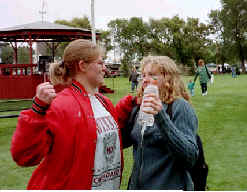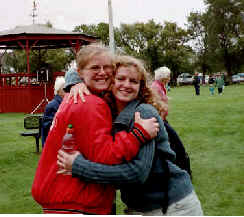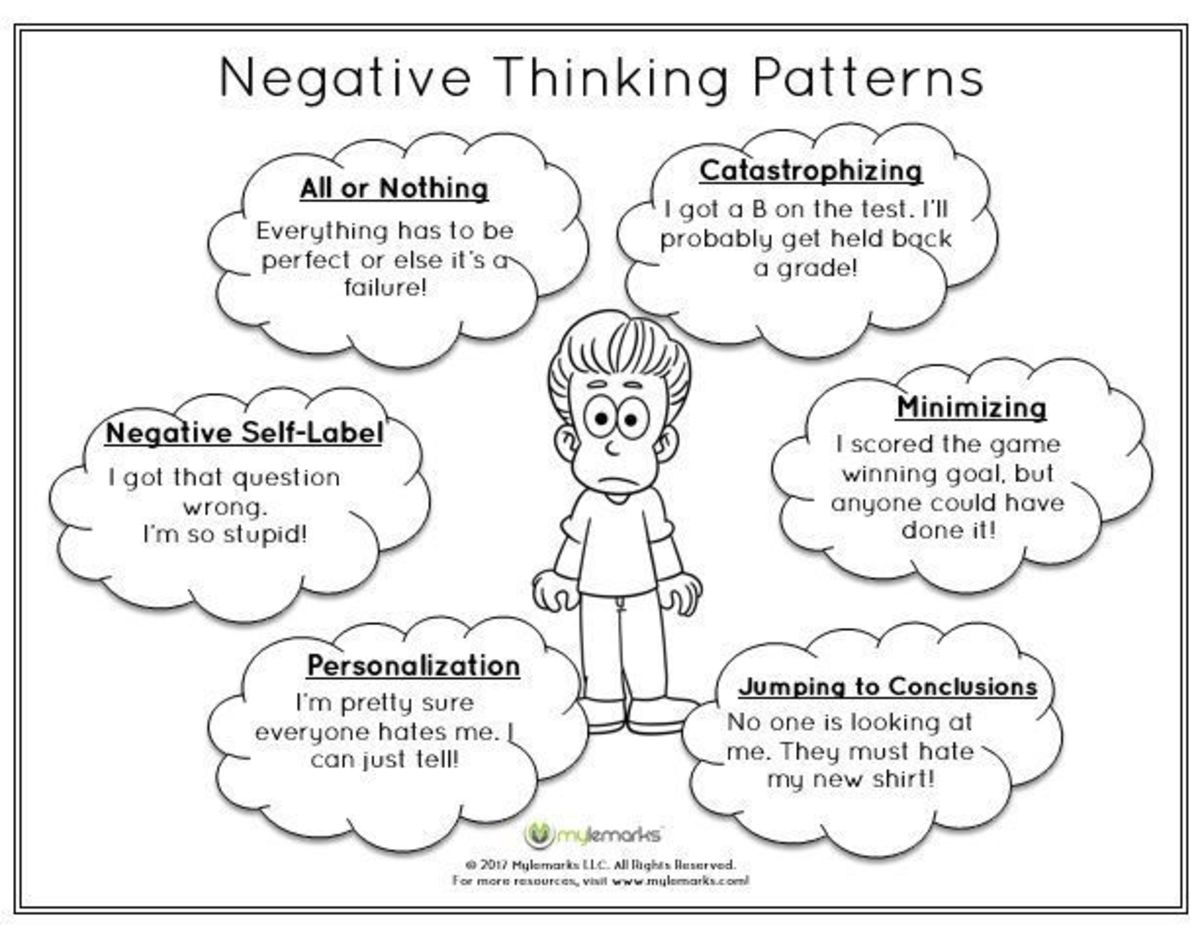- HubPages»
- Health»
- Mental Health»
- Emotions
How to Recognize and Change Distorted Thinking Patterns

What You Think Determines What You Feel
We all have times in life when we stop ourselves and think, "Now why did I do that!" We make mistakes and do things that hurt ourselves and others, sometimes without even realizing what is happening. Someone winces after a comment we make, and then they turn away, or we brush off a child that was in need of love and attention, thinking that they deserved it because of their disobedience earlier in the day.
These moments are often the result of distorted thinking patterns we develop. The negative feelings that follow affect our ability to relate to others in positive ways. They include, but are not limited to exaggeration, black and white thinking, jumping to conclusions, assumptions, "what if" questions, comparisons, helplessness and dependency, and power and control.
Read through the following table to gain an understanding of these distorted thought patterns and see examples of how they are manifested. As you do so, think about the ones you use, then answer the question in the poll.
Distorted thought pattern
| What it is
| Example
|
|---|---|---|
Exaggeration
| Focusing on a single negative detail taken out of context.
| "I can't believe I misspelled that word! The boss must think I'm a stupid idiot!"
|
Black & White Thinking
| Everything is extreme, either totally good or totally bad.
| "These kids are terrible! They cannot be quiet even for a few minutes!"
|
Jumping to Conclusions
| Extending negative feelings by reading other things into it.
| "No one talked to me at the party today. They all hate me."
|
Making Assumptions
| Making decisions based on what we perceive others are thinking.
| "He left right after the performance without even saying good-by. I must have offended him and he doesn't ever want to see me again."
|
"What if" Questions
| Thinking about what might happen to the point that decisions are made based upon it.
| "What if they don't like me?! I'll never have any friends!"
|
Comparison
| Measuring individual weaknesses by other's strengths.
| "She looks like she just stepped out of a fashion magazine. I must look like a slob!"
|
Helplessness and Dependency
| Everything we do is dependent upon someone else.
| "If those other drivers would just watch out where they are going, I would be safe."
|
Power and Control
| The world revolves around us and we affect everyone and everything.
| "He will do it if I hound him enough! He is just lazy."
|
Which distorted thought pattern do you think that you use the most?
Distorted thought patterns feed off of each other
Once we start using a distorted thought pattern, we usually end up having another and another, until our entire thought processes are colored by negativity. It is easy for depression, rage, anxiety, guilt and other negative self esteems to grow and flourish in this kind of environment.
If we can recognize the one that we use the most, we can work on that first. The positive habits developed will affect our ability to recognize and change others as well. Changing our thoughts is a step by step process. We have to:
- Recognize the thought pattern
- Red flag the words that make it irrational or distorted
- Replace these words with ones that will change the thought to a rational one
- Practice doing it over and over
Do you have so many negative thinking patterns that you cannot choose the one that you use the most?
In order to change feelings, we have to change thought patterns
Once we recognize the thought patterns that are giving us issues, we can pinpoint the words that are used in the thought patterns that make them irrational. Read the examples below. The words in bold are what makes the thought irrational. It is followed by changes to make the thought a rational one.
Black and White Thinking
Distorted Thought: "These kids are terrible! They cannot be quiet even for a few minutes!"
We are putting the children at the far end of the spectrum of disobedience for the small infraction of being noisy momentarily.
Rational Thought: "These kids are being really noisy right now. What can I do to help them quiet down?"
Keep descriptions to specific, measurable and observable terms to avoid putting your thoughts at the far ends of the black and white spectrum.
Exaggeration
Distorted thought: "I can't believe I misspelled that word! The boss must think I'm a stupid idiot!"
We are making more of the situation by taking a small thing, a simple word, and blowing it out of proportion to equal an entire reputation at the company (what the boss thinks).
Rational thought: "I can't believe I misspelled that word! Next time, I'll be sure to use the spell checker before handing it in."
Making both sides of the equation equal (word = spell checker), keeps exaggeration at a minimum.
Making Assumptions
Distorted Thought: "He left right after the performance without even saying good-by. I must have offended him and he doesn't ever want to see me again!"
We are deciding that we know how he feels based on our perception of his thoughts.
Rational Thought: "He left right after the performance without saying good-bye. I'll talk to him later to see what is happening."
If we don't know what is happening, we need to check it out before making a decision about it.
Jumping to Conclusions
Distorted Thought: "No one talked to me at the party today. They all hate me!"
We have decided that not being talked to equals hate, an illogical conclusion.
Rational Thought: "That's funny, usually these people are more talkative. I wonder what is happening."
A simple observation of what is happening is all that is necessary. That way, we don't have to make any conclusions. Instead, we are gathering information.

Comparison
Distorted Thought: "She looks like she just stepped out of a fashion magazine. I must look like a slob!"
We are comparing her strength to our perceived weakness.
Rational Thought: "Wow, she looks great! I like the way she put those colors together in that outfit. I'm going to try that!"
Allowing ourselves to look at someone else's talent and ability and take ideas from it rather than comparing, keeps our feelings of self-confidence strong and allows ideas for future improvement based on what is learned.
"What If" Questions
Distorted Thought: "What if they don't like me?! I'll never have any friends!"
Any time a thought begins with the words "What if?" we are worrying about something that most likely will not happen. These types of thoughts usually have words such as "never" and "always" in them.
Rational Thought: "I don't know these people. It may take some time, but I'll find friends."
Leave off the "what if" and get to the real problem. That way, thoughts are not projected to an unknown future before decisions are made, and hope is left intact.
Power and Control
Distorted Thought: "He will do it if I hound him enough! He is just lazy!"
The responsibility is on us to make sure that everyone else does what they are supposed to. We become overworked and stressed by all that needs to be done.
Rational Thought: "He seems to be waiting for me to do something before he will act. It looks like we need to discuss our expectations."
Spreading the responsibility to all involved gives everyone power to act. The responsibility belongs to both to get the job done and a joint plan of action is needed.
Helplessness and Dependency
Distorted Thought: "If those other drivers would just watch out where they are going, I would be safe."
Any time we put the responsibility on someone else to determine our actions, we are becoming helpless and dependent. Our options are limited to what we see others do.
Rational Thought: "I had better be careful, this is a difficult stretch of road."
When we take responsibility for our own actions, we are free to make those choices that keep us safe and happy. Options remain open and we are able to make wise choices for our own benefit and the benefit of others.

Changing Distorted Thought Patterns Changes Our Feelings
As we grow in our ability to recognize and change distorted thought patterns, we grow in our ability to keep our self-esteem strong and our feelings positive. It may take some time initially, but it is well worth the effort in the long run.
This content is accurate and true to the best of the author’s knowledge and is not meant to substitute for formal and individualized advice from a qualified professional.
© 2011 Denise W Anderson








